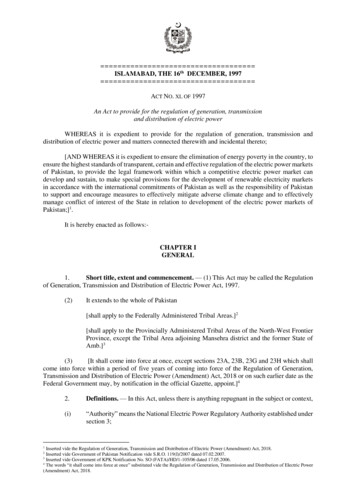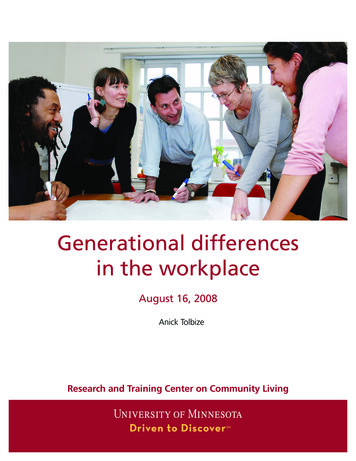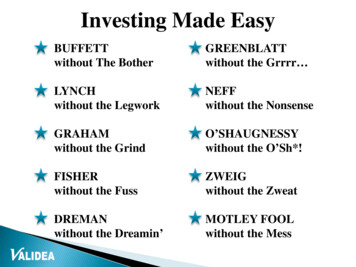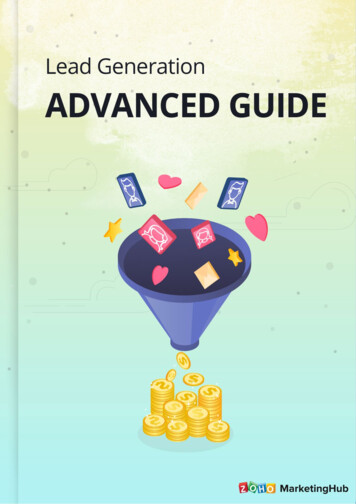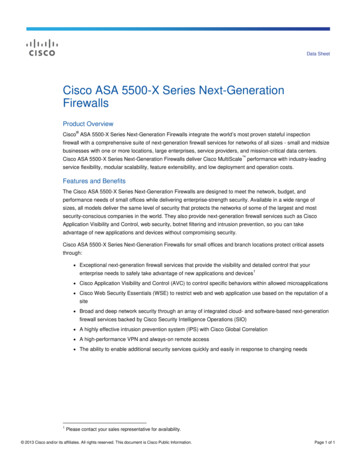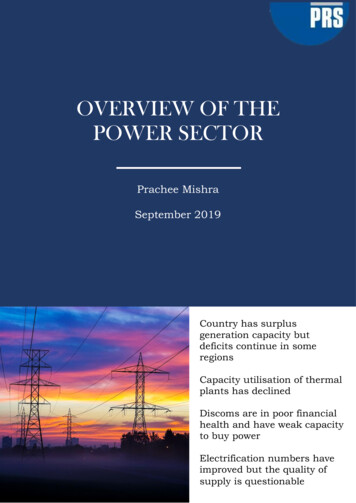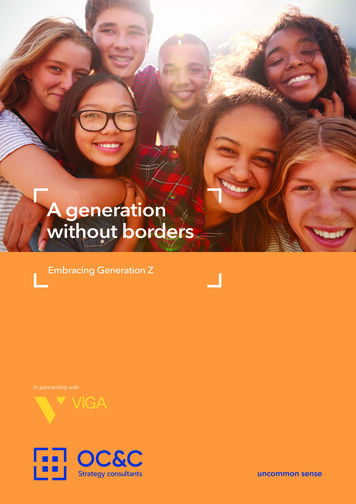
Transcription
A generationwithout bordersEmbracing Generation ZIn partnership withuncommon sense
03 Introduction04 Who are Generation Z?08 Six key findings22 Implications for brands and retailers34 What next?02 OC&C A generation without borders
IntroductionNeedy, entitled, ethical – as the firstgeneration to grow up under the publicgaze of the internet, Millennials mustbe the most talked about, scrutinisedgeneration to date. Yet now, just asbrands finally start understanding thisdemographic, a new group is makingits way onto the consumer landscape:Generation Z.Broadly defined as those born in 1998 and after, this group already makes up30% of the global population and circa 50% in parts of Africa. In little over a decade,Generation Z will account for a third of all consumers worldwide – presenting vastopportunities for businesses.But what about Generation Z today? As the oldest members turn 21 this year,and enter adulthood and the workplace, the opportunity for business is alreadymounting. Businesses – as both brands and employers – are under increasingpressure to understand who these new consumers are and what they want.This study aims to help businesses do just that. Spanning four generations, ninecountries and 15,500 respondents, A generation without borders is the widestgeographical study of Gen Z consumers to date. Through rigorous analysis of over12 million data points, our research provides valuable insight into this alreadymisinterpreted generation, revealing many of the values and attitudes displayedby this group of young consumers – and influencers.Because like the Millennials before them, Generation Z are anything but passiveconsumers. With this generation we enter the age of the influenced and theinfluencer, the finsta and the rinsta, the activist and the individual.A word on generationalresearchGenerational research has longbeen recognised as a valuablemethod of understanding peopleaccording to the economic,political, technological and,increasingly, environmentalcontext in which they wereborn and came of age. Ratherthan stereotype individuals,generational research explores theimpact that global events have onage-specific communities.By viewing consumers through agenerational lens, we can look fortrends and shifts in perspectivesthat transcend age, gender andnationality, which are attributableto global factors instead.But as with all generationalstudies, our findings havecertain limitations. We can’t offerlongitudinal perspectives, sofor example, we can’t comparethe shopping habits of teenageBaby Boomers with GenerationZ. While every effort has beenmade to present findings that arenot attributable to age, makingallowances for age-specificbehaviours remains a criticalchallenge of this type of study.To help you draw your ownmeanings from our research,we’ve presented data alongsideour interpretations throughout.Welcome to Generation Z.In little over a decade, Generation Z willaccount for 33% of all consumers worldwide –presenting vast opportunities for businessesOC&C A generation without borders 03
Who are Generation Z?THE GENERATIONS1928-19451946-19641965-1980Silent GenBaby BoomersGen XWhile the definitive years are stillto be agreed (clearer generationalboundaries will likely emerge overtime), it’s generally accepted thatGeneration Z includes those bornsometime between 1998 and2016.Members of this demographic grew up, or were borninto, an era defined by political and economic turmoil.The financial crisis of 2007, and the 9/11 attacks thattook place six years earlier, meant childhood was a timeof relative hardship set against a backdrop of increasinganxiety for many Western Gen Zers, as both the ‘war onterror’ and Great Recession took hold.And while the Western world struggled, this generationalso witnessed the rapid development of the BRICnations and, more specifically, China’s transformationfrom ‘third world’ to the next potential superpower.Yet despite these events, Gen Zers are not necessarilydefined by these geo-political tumultuous times.Born alongside the commercialisation of the World WideWeb, this group is surely better defined by the era ofunprecedented technological change that has followed.For growing up alongside the internet and thesubsequent dawn of social media, meant a childhoodpunctuated by the many seismic events (the ArabSpring, Donald Trump’s Presidency, Brexit) directlyinfluenced by this medium.Add to all this contemporary events and trends involvingrights and equality – such as the Syrian Civil War and therefugee crisis, the legalisation of gay marriage, the #metoomovement and the rise in populism across the Westernworld – and it becomes clear that Generation Z have livedthrough, or were born into, times of extraordinary change.Today, as the oldest Gen Zers come of age, we’restarting to grasp just how much these worldwide eventsmay have influenced and defined the characteristics ofthese young consumers. We’re seeing how concernsaround social responsibility are affecting purchasedecisions, for example, and that equality and diversity –not the environment – are the most significant issues forthis group of people.TECHNOLOGY TIMELINE, 1998-2017Software/Apps19981999Hardware04 OC&C A generation without borders20002001200220032004200520062007
“When I think of Generation Z, the first thingthat comes to mind is change.”Female, 20, USA1981-19971998-20162017-20?Gen Y/MillennialsGen ZAlpha Gen?The research paints a layered and textured portrait.It shows how, more than any other generation, this oneis subject to influence from celebrities and friends, butalso, the extent to which this cohort wants to stand out asindividuals. Driving these seemingly contradictory forcesis, most likely, the irrefutable influence of social media.Growing up with Facebook, YouTube and WhatsApp,it’s no surprise that Generation Z are prolific and masterfulsocial media users: adept at manipulating the mediumto build influence, make money and discover brands andnew ideas. As the first generation to know nothing but lifewith Snapchat and Renren, platforms like these are whereGen Z socialise, source news, watch videos and carve outmultiple identities. These young adults, teens and tweens,don’t ‘go online’, they live online.This doesn’t mean they’re not concerned by their socialmedia use, however. Over 50% worry about the widerimpact social media has on society, while two in fiveare concerned by the effects social media has ontheir health.200820092010201120122013From selfies to finstasMillennials may have popularised the selfie and‘humble brag’, but we see a trend for multiple accountuse among Gen Zers, suggesting a focus on carefullycurated personas. Furthermore, this generation is theleast likely to limit their social media audience to thosethey know in real life. The result? The birth of the finsta,the so-called ‘fake’ and private Instagram account forclose friends and family only, and the rinsta, the polishedand public ‘regular’ account. And it’s not just Instagram– Gen Z report having multiple accounts across socialmedia platforms.2014201520162017OC&C A generation without borders 05
“What makesus differentfrom any othergenerationis that we aremore cautiousand pragmatic.We grew upduring a globalrecession, war,and terrorism.When planningour futures weseek stabilityand securityrather than theoptimism andflexibility ofMillennials.”Female, 20, UK06 OC&C A generation without borders
Generation Sensible,or Generation Spend?Generation Z are frequently labelled the ‘sensible, stayat-home generation’. Evidence suggests that the rise instreaming, online communities and instant communicationchannels has produced a generation that socialises lessoutside and more inside.We see these ‘sensible’ attitudes reflected in our research too.Growing up in times of economic and political uncertaintyhas clearly had an impact on this group of young consumers.Over 35% are regularly saving for big purchases, with 12% savingfor retirement already.GEN Z SPENDThere are more of themIn developing countries such asNigeria and Pakistan, over 40% of thepopulation are Generation Z. In oursurveyed countries, Gen Z representa larger percentage of the populationin Brazil and Turkey (around a third ofthe population) – significantly morethan in Western countries like the UKand the US (around a fifth).They leave school and enter the workforce earlierIn developing countries Gen Z are more likely to be in employmenthaving left school at an earlier age. This means they are alreadycontributing to household earning and spending earlier than their peersin developed countries.China and the one-child policySince the launch of the one-child policy in 1980, many Gen Zers in Chinawere born as the only child in their family. Being only children, Gen Zersare more likely to receive generous financial support from their parentsthan older generations.of all global household spend0.93.4Gen ZInfluence spend2Gen ZTotal spend2.4That’s not to say that Generation Z doesn’t spend of course.At US 3.4 trillion, this group already accounts for over 7% of totalhousehold spend, even though the vast majority are teenagersor even younger. At the moment, Gen Z’s spend over-indexes intechnology (e.g. their mobile phones and media subscriptions) andclothing, with Gen Z in China, Brazil and Turkey accounting formore household spend than their Western peers.Why Gen Z account formore household spendin developing economies7.5%Global Gen Z Spend, 2018US tnGen ZDirect spend1Gen Z share of household spend, by surveyed country UKDirect spend11.2.3%7%6%3%2%3%2%3% 1%3% 1%2% 1%2% 1%2%3%13%10%8%5%5%4%4%3%3%Influence spend2Direct spend: Gen Z spending their own money (either earned or money receivedfrom parents/guardians/relatives, e.g. allowance/pocket money)Influenced spend: household spending where Gen Z influences either the amountspent or the items bought (i.e. can be items not bought specifically for Gen Z)Source: UN; World Bank; CEIC; National Bureau of Statistics of China;OC&C Gen Z Survey, August 2018OC&C A generation without borders 07
Our key findingsGen Z are:MoreglobalUnder theMoreinfluence demanding“With how social mediaspreads news around,we are very educatedin how the world is.”“I keep up withcelebrities, influencers,and sometimes brandsthrough Instagram.”Female, 20, USFemale, 17, US“Brands need to workmore to retain theircustomers (since ourchoices have really gottenpretty limitless) – I wouldlike it if they increasedtheir offerings and makeit easier to find things thatyou’re looking for.”Female, 20, US08 OC&C A generation without borders
Eager toAfterPro socialstand out experiences (responsibility)“Generation Z is morefocussed on innovationand uniqueness.”Male, 19, China“The experiences I havehad, they do define mein a way – not so thatI can show off about them,but what they have taughtme is really valuable.”Male, 20, UK“Ethics and message aremost important to me you cannot expect peopleto buy your products ifyour ethics are trash.”Female, 17, USOC&C A generation without borders 09
“With how social media spreadsnews around, we are veryeducated in how the world is.”Female, 20, US10 OC&C A generation without borders
Gen Z are more globalFrom attitudes to spending, to theiroutlook on the future, Gen Zers acrossthe globe are resembling each othermore than any other generation.ATTITUDES AND BEHAVIOURS ACROSSCOUNTRIES ARE MOST SIMILAR IN GEN ZDifferences in Attitudes, Behaviours and Purchase Criteria acrosscountries by generation(% Delta between highest and lowest countries)Attitudes23%Compared with older generations, we see greatest similaritiesin behaviours and attitudes in the Gen Z respondents of all ninecountries we surveyed. This suggests a homogenising effect that isalmost certainly being driven by technology – primarily the internet,but also the increasing accessibility of low cost travel. The internetand social channels make it ever easier for this online generationto share ideas and access the same information and media.Brands and celebrities appear to be playing their part in this trendtoo. As brands expand further into new and developing markets,often through leveraging the power of truly global celebrities andinfluencers, Gen Zers increasingly share access to the same productsand services. As a result, online and in the media at least, the worldcan look surprisingly similar for Gen Zers in Germany or the US.16%13%10%ExampleQuestionTo what extentdo you agree withthe following:“I am worriedabout the futureof the tionHow frequentlydo you makepurchasesthrough socialmedia platforms?Purchase Criteria27%20%17%15%Baby BoomersMillennialsExampleQuestionWhich of thefollowingelements aremost importantto you whenbuying clothes?Gen XGen ZSource: OC&C Gen Z Survey, August 2018OC&C A generation without borders 11
Gen Z are underthe influenceInfluence plays a huge role in the life of Gen Zers. They report higher levels ofinfluence on their life choices than older generations, and are more likely to beinfluenced by friends and celebrities than older generations.This tendency towards influence is reflected in theirpurchase decisions too. We see traditional purchasejourneys disrupted as a much wider set of inspirationscontribute to Gen Z’s purchase decisions. So whereasGeneration X, the Millennials and Gen Z may all shoponline and are all influenced by a brand’s social media(though Gen X less so), Gen Z’s list of influence extendsfurther and is more evenly spread. Mobile apps, friends’and celebrities’ social media and blogs are biggerinfluences for Gen Z than for older generations.We see young people diverging from traditionalsources of brand discovery too. When asked to selectbrand discovery channels, just 8% of Gen Zers selected,‘Seeing the brand when out shopping’ comparedwith 24% of Baby Boomers and 17% of Gen Xers.Instead, friends and family are the two most importantdiscovery channels for this group, with more thana third selecting these channels.Despite their age, Gen Zers are already influencingtheir peers by readily interacting with brands onlineand on social media. Gen Z are the most likelygeneration to follow brands and retailers on socialmedia, to repost brands’ own posts and to write onlinereviews. This generation already knows its mind andisn’t afraid to speak it.“I keep up withcelebrities, influencers,and sometimes brandsthrough Instagram.”Female, 17, US“I will ‘reward’ brands I’ll buy morefrom that company, tell my friendsabout them and suggest productsfrom their website.”Female, 20, US12 OC&C A generation without borders
GEN Z CONSULT MORE SOURCES FOR PRODUCT INSPIRATIONSources of clothing purchase inspiration1Average number of sources for purchase inspiration# Sources (Online and offline)2.52.72.93.0Baby BoomersGen XMillennialsGen ZGen Z online sources of inspiration% Selecting answer as source of inspiration for most recent purchaseGen ZMillennialsBrand online store25Brand social media20Online multi-brandstore20Brand mobile app87-212-1-1-11041015Friends/celebrities’social mediaBaby Boomers2119Online advertGen X-314462Online search(search engine)130Multi-brand storeapp130Online magazine/blog121012246371. Thinking about your most recent clothing purchase, did any of the following inspire the purchase?Source: OC&C Gen Z Survey, August 2018GEN Z’S CHANGING CHANNELS FOR BRAND DISCOVERYBrand discovery1 (Clothing & Beauty) – by channel% of survey respondents (for last brand discovered)-16ppt-2ppt-2ppt-1ppt0ppt0ppt 1ppt 1ppt 2ppt 4ppt 5ppt 9ppt2417 1717118Seeing thebrand outshopping65 5458489Gen X1517191611843 3Seeing the Recommend- Throughbrand on aation tant/websiteserverBaby Boomers1517ThroughfamilyMillennials4 4 4Throughprintreviews233 3456 roductdiscussionplacement nfluencer,e.g. vlogger/blogger/social endsGen ZThinking about the last time you were introduced to a new brand that you subsequently bought yourself, how did you discover the brand?Source: OC&C Gen Z Survey, August 20181.OC&C A generation without borders 13
Gen Z aremoredemandingWhile price and quality remain the mostimportant criteria for choosing retailers,Gen Z have a wider set of KPCs than oldergenerations. This group places a highervalue on secondary factors such as style,sustainability, uniqueness and flexibility,and attaches more importance to a brand’sethics. We see this trend reflected in foodshopping too, where Generation Z placesgreater value on factors like curation andsustainability.Furthermore, Gen Z are already showing signs of being enthusiasticresearchers, though not quite to the same degree as Millennials.They are much more likely to go directly to brands’ online channelsto research and price-check products before they buy than oldergenerations. Interestingly, Gen Z appear much more targeted in theirresearch as they are less likely to use broader search channels such assearch engines or multi-brand platforms. This research channel shiftwe have observed will have implications for brands trying to accessthese youngest consumers, particularly in terms of marketing mixspend allocation.This combination of a wider set of purchase criteria and moretargeted research before making a purchase, suggests aconsumer who’s possibly better informed and who’s mostcertainly more demanding.14 OC&C A generation without borders
“Brands need to work moreto retain their customers (sinceour choices have really gottenpretty limitless) – I would like itif they increased their offeringsand make it easier to findthings that you’re looking for.”Female, 20, USGEN Z HAVE DIFFERENT KPCsKey purchase criteria for clothing1Importance of criteria for Gen Z% respondents selecting criteria in their top 3 most importantGen Z vs average of other generations%pt delta55PriceQuality1%53Range-7%26Suits ship3%82%1. When shopping for the following products, what are your top priorities? [Clothing]Source: OC&C Gen Z Survey, August 2018GEN Z DO MORE PURCHASE RESEARCH ONLINE DIRECTLYWITH BRANDSResearch channels1Average number of channels used for research# Sources (Online and offline channels)Gen Z vs average of other generationsBrand online platforms24Online media332Offline media42.1Baby Boomers2.32.5Gen X2.40Multi-brand online platforms5-2Brand storeDepartment store-3Search engine-3MillennialsGen ZThinking about your most recent clothing purchase, what did you use to research the product or check prices?Brand website, mobile app and social mediaOnline news sites, magazines, blogs4.Newspapers and magazines5.Multi-brands websites, mobile app (e.g. Amazon)1.2.3.Source: OC&C Gen Z Survey, August 2018OC&C A generation without borders 15
Gen Z wantto stand outIn a world where everyone has a platformthough social media, many Gen Zers havea strong desire to stand out and feel unique.We see this reflected in their attitude eventowards their own opinions – nearly a quarterbelieve having a unique point of view isvery important – as well as their viewson style, hobbies and creativity.The desire to feel unique directly informs what Gen Z want fromretailers, with demand for bespoke and limited edition highestamong this generation. This increased demand for uniquenessin their product choices was observed across both clothing(see page 15 Gen Z have different KPCs chart) and beauty andgrooming products. Furthermore, when asked about foodshopping, interest in unusual or exotic products was highestamongst this generation. But this doesn’t mean Gen Z arecompletely dismissing mainstream brands; of the fourgenerations, Gen Zers expressed the strongest desire topurchase well-known brands and wear products withvisible branding.“Generation Z is morefocussed on innovationand uniqueness.”Male, 19, China16 OC&C A generation without borders
GEN Z PLACE MORE IMPORTANCE ON BEING UNIQUEImportance of uniqueness% identifying the statement as “Very important”Having unique points of view/opinions 4%19%18%19%23%Creating unique content (video, photo, blog, other writing or art) 9%9%11%14%18%Having a unique style 7%9%11%12%16%Having unusual hobbies/interests 6%10%Baby Boomers11%Gen X13%Millennials16%Gen ZSource: OC&C Gen Z Survey, August 2018; OC&C analysisOC&C A generation without borders 17
Almost a fifth of Gen Z respondentsstrongly agree that they “would ratherspend money on experiencesthan products”Gen Zwant experiencesTheir predecessors may have coined the phrases FOMO andYOLO, but Gen Z are even more intent on choosing experiencesover products than Millennials. Almost a fifth of Gen Z respondentsstrongly agree that they “would rather spend money on experiencesthan products”.Across the countries we surveyed, the largest swing between Millennials and Gen Z were observed in Germanyand China with 4-5 %pt increases in those wanting experiences over products.Interestingly, this desire for experiences appears to be, at least partly, correlated with lower materialism anda concern for sustainability. And while the Gen Zers who place particular value on experience tend to beslightly wealthier on average, we still see this trend reflected across all income brackets.18 OC&C A generation without borders
“The experiences I have had, they do define mein a way – not so that I can show off about them,but what they have taught me is really valuable.”Male, 20, UKOC&C A generation without borders 19
Gen Z are pro social(responsibility)We saw conscious consumption go mainstream with Millennials,and Gen Z look to be continuing the trend. In particular, issuesof social responsibility have captured the attention of Gen Z.Testing a range of ethical issues showed animal welfare, equality, diversity and human rights are most important toGen Z overall. Our data also reveals national differences that appear to directly reflect the political climate of thecountry. In China, Gen Z are more concerned by human rights issues, while American Gen Zers (the most racially andethnically diverse generation in the US) are most committed to solving diversity issues. It has been widely reportedthat Gen Z exhibit much more fluidity in terms of gender and sexuality than previous generations – as a result theyare much more aware of issues surrounding diversity and tolerance.Our data shows that for several of the social issues in which Gen Z are most engaged – combatting inequality,supporting human rights and encouraging diversity – this group are the most engaged generation overall.However, our data doesn’t suggest that older generations are less socially responsible than Generation Z. Rather,this generation has selected a different set of concerns to focus on from those prior.Gen Z’s social values are not just reflected in how they interact with one another or society in general, but are reflectedin their consumer behaviours as well: a higher percentage of Gen Zers choose brands that reflect their ethos.GEN Z PRIORITISE SOCIAL RESPONSIBILITYResponsibility attitudes% Respondents stating “I am fully committed to this”Generation ZDelta vs Average Previous GenerationsPromoting animal welfare22Ensuring my family have good opportunities22Supporting human rights organisations17Combating inequality in the community171-24516Diversity in workplace/educational insitituteReducing amount of waste I create15Safety of my neighbourhood15Helping to build local communities14Reduce my carbon footprint145-743-3Purchasing products on basisof sustainability/ethical concerns13Reducing use of single-use plastic13-8Social responsibilityEthical/OtherEnvironmental responsibilitySource: OC&C Gen Z Survey, August 201820 OC&C A generation without borders3
“When you think about new things you buyyou never think of the environmental costsbefore you are done with using the product.”Female, 20, US“Ethics and message are most important tome. you cannot expect people to buy yourproducts if your ethics are trash.”Female, 17, US“I think we’re a more open-mindedgeneration, as we’re on the whole verytolerant and accepting of different races,religions and sexualities than in the past,and aren’t afraid to voice our opinions toprotect certain groups’ rights.”Female, 20, UKGen Z and the environment(it’s complicated)At first glance, social issues appear to be moreimportant than environmental ones for Gen Z. Just13% of this group say they’re trying to cut downon using single-use plastic, compared with 30% ofBaby Boomers and 15% of Millennials. From theseresults it’s possible to suggest that Gen Z are more‘committed’ to solving issues which require less of alifestyle change. Yet Gen Z are concerned about theirconsumption: a quarter (27%) prefer buying productsthat can be used repeatedly and more than a third(37%) try to buy and keep only what they truly need.They’re engaged with sustainability when it comesto food shopping too, with one fifth selecting thisas a key purchase criteria – more than Millennialsand Gen X.OC&C A generation without borders 21
What doesthis mean forbusinesses?7GET YOURSTORYSTRAIGHTGen Zare moredemandingGen Zare pro social(responsibility)6ETHICSBEYONDCOMPLIANCE5THE (SOCIAL)NETWORK EFFECT22 OC&C A generation without bordersGen Zare underthe influence
We have mapped a setof implications for brandsand retailers against ourkey findings.1THE NEWSEGMENTATIONThis latter point is of particularsignificance. Our research disprovesthe theory that certain Millennial trends(such as the appeal of experiencesover possessions) are fads, suggestingthe socially conscious, experience-ledconsumer is here to stay for a while.But of course that’s not to say thisgeneration are simply an extension ofthe Millennials. Our data-driven insightsidentify several key trends particular tothis demographic and the actions brandsmust consider when targeting this verydistinct new consumer.Gen Zare moreglobal2Gen Zwant tostand outGen Zwantexperiences4As our research demonstrates,understanding the Gen Z consumer is farfrom straightforward. We see this groupdisplaying their own distinct consumerpatterns, while sharing attitudes witholder generations and carrying forwardtrends established by the Millennials.3JUST UNIQUEENOUGHDRIVING VALUEFROM EXPERIENCECONSUMERCOMMUNITIESOC&C A generation without borders 23
Implication 1The new segmentationAs the first generation born after the commercialisationof the internet, this cohort has grown up with more accessto entertainment, brands and celebrity than any othergroup. Meanwhile, the rise in social media and onlinenews broadcasting has turbocharged global awareness ofcampaigns, ideas and issues – while making communicatingabout these issues easier than ever before. As a result, we seethe emergence of country-agnostic tribes sharing attitudes andbehaviours. These new, borderless and globalised consumersare hungry for unique products, services and experiences.ACTION POINTSSTEP 1CHOOSE YOUR AXES OFSEGMENTATIONSTEP 2ADJUST YOUR OFFER FOR YOURCHOSEN SEGMENTSSTEP 3REVISIT YOUR SEGMENTATIONREGULARLYTraditional segmentation axes –often along lines of geography, age,purchase behaviours and affluence – areincreasingly less relevant for this globalgeneration. New axes, fuelled by theinternet and social media – value sets,influence groups, experience types oreven celebrity following – cut through thetraditional axes. Though as with traditionalsegmentation, the ‘new segmentation’should reveal consumer groups withdistinctive purchasing habits and brandpreferences to make them actionable.Understanding and defining the rightsegmentation for your industry can provecritical in developing and nurturingyour brand, but the real power of thenew segmentation is in adjusting yourproducts and messaging to make themmost relevant for your chosen segments.International retailers Zara and ASOSare able to respond to different ‘tribes’around the world through rapid reactiveproduction as they identify consumerrequests at the global level, in addition toadjusting their tone of voice for each ofthose tribes.Given the fluid nature of the newsegmentation dimensions, it is importantto review and update your segmentationregularly, much more so than for thetraditional axes.24 OC&C A generation without borders
Implication 2Just unique enoughACTION POINTSSTEP 1IDENTIFY THE VALUE FOR YOURBUSINESSThe benefits from investing in ‘just uniqueenough’ are not just attractive, they’recritical: Increase consumer loyalty throughproducts that speak more clearly toconsumers Decrease price competition, asproducts have reduced comparability Power your online business, as thewebsite is the natural personalisationtool Gain better consumer insights, as youunderstand the degrees of uniquenessthat consumers want.When it comes to choosing products and brands,Gen Z consumers look for clothing, accessoriesand even groceries that are unique or unusual.However, this group also supports mainstream brandsand enjoys wearing clothes with recognisable logos.In other words, Gen Z want to stand out, but withindefined limits.STEP 2CHOOSE YOUR ‘UNIQUENESS’MODELThere are a number of different models toconsider, including: ‘ One of a kind’ – Genuinely individual,‘one-off’ products and services allowconsumers to feel truly unique. There aredifferent individuality dimensions thatbrands can consider when delivering‘one of a kind’ at scale – from changes tofit or colour through to packaging andeven customer support Personalisation – Letting the consumerguide the product aesthetic orspecifications makes them feel moreindividual while delivering a more intimatebrand experience. Nike, one of Gen Z’sfavourite brands, allows consumers tocustomise their own trainers throughtheir NikeiD offerin
Because like the Millennials before them, Generation Z are anything but passive consumers. With this generation we enter the age of the influenced and the influencer, the finsta and the rinsta, the activist and the individual. Welcome to Generation Z. In little over a decade, Generation Z will account for 33% of all consumers worldwide -


